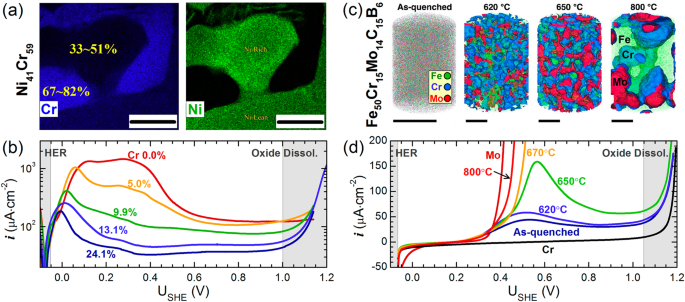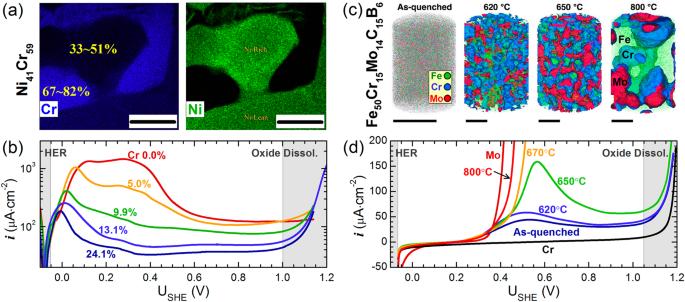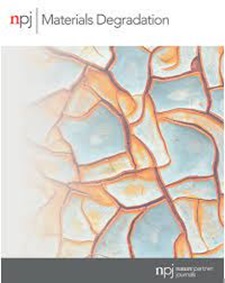Elemental partitioning and corrosion resistance of Ni–Cr alloys revealed by accurate ab-initio thermodynamic and electrochemical calculations
IF 6.6
2区 材料科学
Q1 MATERIALS SCIENCE, MULTIDISCIPLINARY
引用次数: 0
Abstract
Elemental partitioning during thermal processing can significantly affect the corrosion resistance of bulk alloys operating in aggressive electrochemical environments, for which, despite decades of experimental and theoretical studies, the thermodynamic and electrochemical mechanisms still lack accurate quantitative descriptions. Here, we formulate an ab initio thermodynamic model to obtain the composition- and temperature-dependent free energies of formation (ΔfG) for Ni–Cr alloys, a prototypical group of corrosion-resistant metals, and discover two equilibrium states that produce the driving forces for the elemental partitioning in Ni–Cr. The results are in quantitative agreement with the experimental studies on the thermodynamic stability of Ni–Cr. We further construct electrochemical (potential–pH) diagrams by obtaining the required ΔfG values of native oxides and (oxy)hydroxides using high-fidelity ab-initio calculations that include exact electronic exchange and phononic contributions. We then analyze the passivation and electrochemical trends of Ni–Cr alloys, which closely explain various oxide-film growth and corrosion behaviors observed on alloy surfaces. We finally determine the optimal Cr content range of 14–34 at%, which provides the Ni–Cr alloys with both the preferred heat-treatment stability and superior corrosion resistance. We conclude by discussing the consequences of these findings on other Ni–Cr alloys with more complex additives, which can guide the further optimization of industrial Ni–Cr-based alloys.


通过精确的非原位热力学和电化学计算揭示镍铬合金的元素分配和耐腐蚀性能
热加工过程中的元素分配会严重影响在侵蚀性电化学环境中工作的块状合金的耐腐蚀性,尽管已经进行了数十年的实验和理论研究,但热力学和电化学机制仍然缺乏准确的定量描述。在此,我们建立了一个ab initio 热力学模型,以获得 Ni-Cr 合金(一类典型的耐腐蚀金属)随成分和温度变化的形成自由能 (ΔfG),并发现了产生 Ni-Cr 中元素分配驱动力的两种平衡态。这些结果与有关镍铬热力学稳定性的实验研究在数量上是一致的。我们利用包括精确电子交换和声波贡献的高保真非线性计算,获得了原生氧化物和(氧)氢氧化物所需的ΔfG 值,从而进一步构建了电化学(电位-pH)图。然后,我们分析了镍铬合金的钝化和电化学趋势,这密切解释了在合金表面观察到的各种氧化膜生长和腐蚀行为。最后,我们确定了 14-34% 的最佳铬含量范围,该范围可为 Ni-Cr 合金提供首选的热处理稳定性和优异的耐腐蚀性。最后,我们讨论了这些发现对其他含有更复杂添加剂的镍铬合金的影响,这些发现可以指导工业镍铬基合金的进一步优化。
本文章由计算机程序翻译,如有差异,请以英文原文为准。
求助全文
约1分钟内获得全文
求助全文
来源期刊

npj Materials Degradation
MATERIALS SCIENCE, MULTIDISCIPLINARY-
CiteScore
7.80
自引率
7.80%
发文量
86
审稿时长
6 weeks
期刊介绍:
npj Materials Degradation considers basic and applied research that explores all aspects of the degradation of metallic and non-metallic materials. The journal broadly defines ‘materials degradation’ as a reduction in the ability of a material to perform its task in-service as a result of environmental exposure.
The journal covers a broad range of topics including but not limited to:
-Degradation of metals, glasses, minerals, polymers, ceramics, cements and composites in natural and engineered environments, as a result of various stimuli
-Computational and experimental studies of degradation mechanisms and kinetics
-Characterization of degradation by traditional and emerging techniques
-New approaches and technologies for enhancing resistance to degradation
-Inspection and monitoring techniques for materials in-service, such as sensing technologies
 求助内容:
求助内容: 应助结果提醒方式:
应助结果提醒方式:


